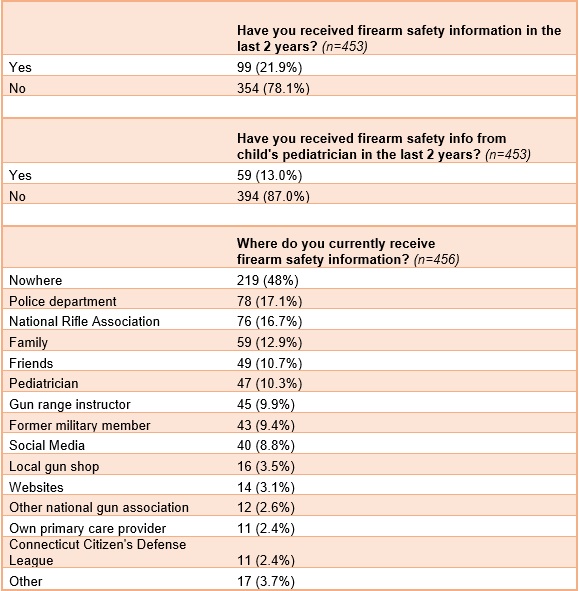Back
Injury Prevention
Category: Abstract Submission
Injury Prevention I
116 - Caregiver Perceptions of Firearm Education
Sunday, April 24, 2022
3:30 PM – 6:00 PM US MT
Poster Number: 116
Publication Number: 116.329
Publication Number: 116.329
Rahul Shah, Connecticut Childrens Medical Center (Hartford, CT), New Haven, CT, United States; Sharon Smith, Connecticut Children's Medical Center/UConn, Canton, CT, United States; Brendan T. Campbell, Connecticut Children's Medical Center, Hartford, CT, United States; Kevin Borrup, Connecticut Children's Medical Center, Hartford, CT, United States; J. Leslie Knod, Connecticut Children's Medical Center, hartford, CT, United States; Garry Lapidus, Connecticut Children’s, Hartford, CT, United States; Mohsin Mirza, University of Connecticut, Avon, CT, United States; Sumeet Kadian, University of Connecticut, East Lyme, CT, United States; Danielle Chenard, Connecticut Children's Medical Center, Hartford, CT, United States; Steven C. Rogers, Connecticut Children's Medical Center, Glastonbury, CT, United States
- SS
Sharon Smith, MD (she/her/hers)
University of Connecticut School of Medicine
Canton, Connecticut, United States
Presenting Author(s)
Background: Youth suicide has increased at an alarming rate and is now the second leading cause of adolescent death in the United States. The presence of a firearm is correlated with a significant increased risk of suicide death. It is unclear from whom caregivers receive information on firearm safety and would be most receptive.
Objective: To determine the frequency and venue of firearm education for a cohort of adult caregivers who presented to the pediatric emergency department; specifically, a) if/where they currently receive information b) where they prefer to receive information, and c) knowledge of best safety practices.
Design/Methods: This tablet-based anonymous survey was given to a convenience sample of parents in a large, urban tertiary-care hospital between November 2020 and November 2021. Any caregiver who provided shelter for the child at least 20 hours/week was eligible. It was available in both English and Spanish.
Results: A total of 485 subjects participated:16.9% reported having a firearm in their home, 21.9% reported receiving firearm safety information in the last two years, with 13.0% from their child's primary care physician. Caregivers reported currently receiving firearm safety information from a police department (17.1%) and guns’ rights organizations such as the National Rifle Association (16.7%). There was an association between having a firearm in one’s home and receiving safety information in the last two years (p=0.03). 29.1% were aware of American Academy of Pediatrics (AAP) best practices for firearm storage. Knowledge of the AAP recommendations and owning a firearm were correlated (x22= 33.1, p < 0.01). Having a firearm in one’s home was correlated with not believing pediatricians should discuss firearm safety with families (x22= 10.9, p < 0.01). Rates of firearm possession were similar between parents who reported mental health concerns (31.1%) for their children and those who did not. Conclusion(s): The majority of caregivers did not recall receiving information about firearm safety in the last two years and were unaware of AAP best practices for storage. Most firearm education is not provided by pediatricians. There may be opportunities for pediatricians to partner with organizations to disseminate high-quality information related to firearm safety.
Rahul Shah's CVRDSHAH.CV (1).pdf
Table 2 Receipt of Firearm Safety Information
Receipt of Firearm Safety Information
Objective: To determine the frequency and venue of firearm education for a cohort of adult caregivers who presented to the pediatric emergency department; specifically, a) if/where they currently receive information b) where they prefer to receive information, and c) knowledge of best safety practices.
Design/Methods: This tablet-based anonymous survey was given to a convenience sample of parents in a large, urban tertiary-care hospital between November 2020 and November 2021. Any caregiver who provided shelter for the child at least 20 hours/week was eligible. It was available in both English and Spanish.
Results: A total of 485 subjects participated:16.9% reported having a firearm in their home, 21.9% reported receiving firearm safety information in the last two years, with 13.0% from their child's primary care physician. Caregivers reported currently receiving firearm safety information from a police department (17.1%) and guns’ rights organizations such as the National Rifle Association (16.7%). There was an association between having a firearm in one’s home and receiving safety information in the last two years (p=0.03). 29.1% were aware of American Academy of Pediatrics (AAP) best practices for firearm storage. Knowledge of the AAP recommendations and owning a firearm were correlated (x22= 33.1, p < 0.01). Having a firearm in one’s home was correlated with not believing pediatricians should discuss firearm safety with families (x22= 10.9, p < 0.01). Rates of firearm possession were similar between parents who reported mental health concerns (31.1%) for their children and those who did not. Conclusion(s): The majority of caregivers did not recall receiving information about firearm safety in the last two years and were unaware of AAP best practices for storage. Most firearm education is not provided by pediatricians. There may be opportunities for pediatricians to partner with organizations to disseminate high-quality information related to firearm safety.
Rahul Shah's CVRDSHAH.CV (1).pdf
Table 2
 Receipt of Firearm Safety Information
Receipt of Firearm Safety Information